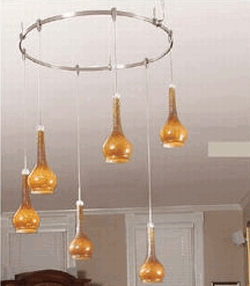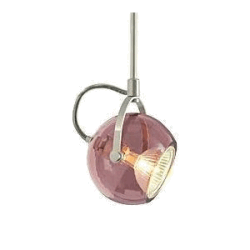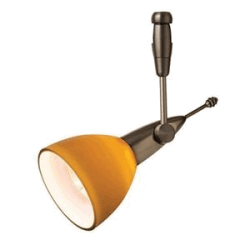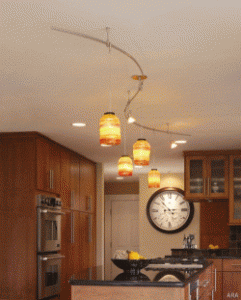Designer Track Lighting: Track, Fixture and Designer Options
Designer track lighting provides options both for style and lighting quality.
At first, designer track lighting may sound like an oxymoron. Track lighting used to look almost entirely industrial. In fact, many considered that a part of its appeal. However, gradually people have been less enthused by the industrial appearance, but still wanted to keep its flexibility and high-quality task lighting. As a consequence, designer tracks and fixtures have become increasingly popular.
Designer track lighting shies away from the industrial look in favor of fixtures and tracks that are themselves attractive. This can be tricky. Track lighting includes both a track and fixtures. However, its use of lines and geometry makes it very well suited to both classic and contemporary ceiling lighting. In this article, I will introduce some of the design options as well as the most popular designers, so that you can make the best decision.
Design Choices: Tracks

By combining flexible tracks with a range of fixtures, the options are almost endless. This kit is available at Amazon.
Perhaps the most important change in designer track lighting is the wide array of tracks now available. In general, you have three sorts of options:
- Material: Which sort of material you build your track out of can affect the overall appearance of your room. If you are using other metallic fixtures, it is often attractive to make your tracks out of metals that match those fixtures. For example, if you are trying for a more rustic appearance, you could try to find a material that mimics wrought iron. Note that, because your track needs to be conductive, some tracks will only appear to be the material you are simulating (still, your guests shouldn’t be able to tell that from the ground).
- Curvature: Many tracks today are curved, rather than the standard straight tracks. In general, curvature is more attractive when you have other curved objects in your home. This integrates your designer track lighting more fully into your room’s design. One popular option is to have the curved track follow moulding details on the ceiling. Another option is to have it follow the expected outline of your furniture. Like any lines in a room, track lighting will direct the eyes from one end to the other, so you can use this to bring the eyes of your guests upwards.
- Style: Tracks also come in a number of different styles. Tracks can appear to be a metal beam across your ceiling, similar to the more industrial look in the past. They can also be round looking like a metallic pole, well suited to rooms that use brass decorations. You can even have tracks that are painted black or other colors, well suited to some more contemporary styles in decorating.
Design Choices: Fixtures
Your second decision in choosing designer track lighting is the kind of fixtures you will attach to the track. There are even more options available in fixtures than there are in tracks:

Pod lights bring a futuristic appearance to your accent lighting. This model is available at Amazon.
First, you have options in terms of accent lighting. These are lights that provide directed light in a single direction, used to highlight various decorative aspects of a room. Even when the type of light is similar, there are different styles of fixtures available:
- Pod Lights: These are globular light fixtures that have a very modern, even futuristic appearance. They come in a number of different colors or metallic shades. They look excellent in modern design, but be careful, as they can look a bit “sci-fi” if combined with too much other futuristic design.
- Spots: Technically, all directed lights are “spots”, but the “spot” style of directed light refers to a cylindrical light that resembles traditional spotlights from the theater. They look excellent in more industrial designs, but your décor can start to resemble an art gallery if they are used too heavily.
- Sportster: These light fixtures are pure industrial style. Not only can you see the front of the bulb, you can even see its back. The bulb is placed inside of a wire and chrome array where minimalism takes the place of detail. Strangely, these stand out less than spots, simply because there is less to look at. However, be aware that when choosing a sportster, you are choosing a very industrial design.
Second, you have options in pendant lighting. Pendant lighting includes lights that hang from the tracks and provide general illumination to the room, rather than lighting particular accents on the walls. They are usually chosen because track lights are an easy way to provide multiple ceiling light sources without using multiple electrical sources.
- Martini: Martini glass fixtures are one of the most popular style of pendant lighting. It includes any style of lamp that looks like an upside-down glass (whether or not it is actually a martini glass). The glass can be colored and can include decorations of various kinds. These lights are popular, since the light both goes downward onto a table or counter, and upward onto the ceiling, providing general ambient lighting. Be very careful with color on martini glass fixtures, as you can throw off the coloration of your entire room with colored ambient lighting.
- Lamp-style: Lamp-style fixtures have a translucent shade that diffuses the light that comes from the light, while still casting light downward. The quality of light isn’t much different from martini pendants, but the style is quite different. The lamp itself is less bright to look at, and the color changes are less severe than with martini styles. Because the light is diffuse before it reaches the track, the track will cast a less strong shadow on your ceiling.
- Tube: Tube-style fixtures require a special mention. Unlike most fixtures, they do not diffuse the light that goes upward. This has two effects. First, you will have much brighter ambient lighting that reflects off the ceiling. Second, you will see the shadow of the track much more clearly, since there is nothing between the track and the light source.
Which type of track and fixture you use will depend on your needs, but the above should provide a number of important considerations for making that decision.
Design Choices: Companies
There are a number of companies with a wide array of choices for designer track lighting. Below are three of the most popular:

LBL blurs the line between accent and pendant lighting. This model is available at Amazon.
- Prima Lighting: Prima Lighting provides both a large selection of straight tracks in multiple materials, as well as numerous connectors to allow flexibility. Their selection of curved tracks is somewhat limited. In a way, their system is too flexible, reducing the number of types of track to ensure that everything is compatible. Their selection of pendant lights is fun and snazzy. There is a wide range of contemporary options, but not much with a “classic” look.
- WAC Lighting: WAC lighting is one of the best sources for actual accent lighting. They provide a large number of spots of very styles, including traditional spot lights and sportsters. They also provide some excellent options for lighting works of art, including spots with screens so that you only light your painting and nothing around it. They offer almost no pendant lights.
- LBL Lighting: LBL Lighting has tried to do something different with its selection of lighting fixtures. They try to make attractive and stylish accent lights. Does it work? Sometimes. At times, putting a martini glass on a spot light can look odd and chimerish. However, at other times, they really get it right. Just be careful about colors, as colored glass can really affect your room’s color scheme.
All of these companies provide quality designer track lighting, but each has its own focus and strengths.
Putting It All Together
There are a number of important things to consider when choosing designer track lighting:
- What style will I use for the track, including materials, shape and style?
- What kind of fixtures will I use, whether for accent or pendant lighting?
- What are the strengths and weaknesses of the various designers that are available?
With these questions in mind, you should be able to make the best decisions about designer track lighting for your home.
